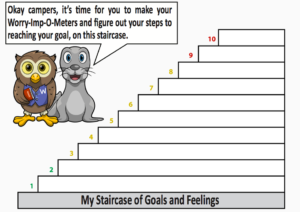
One of the explanations for the low levels of resilience seen in many first year college or university students, is that they haven’t had enough opportunities to face challenges when they were younger.
(See my previous article: Whose Responsibility Is It? Take the Quiz!)
So the big question is… How Much Does One Push An Anxious Child?
If you’ve ever tried to get anxious kids to do something that they’re not comfortable doing, you know it can feel as if their fur is up, claws are out and they are on guard!
It’s very challenging to push an anxious child!
My recommendation is to take small, manageable steps and create a visual staircase where you write the final goal at the top of the staircase.
I’ll use the example of chronic school refusal to describe the “staircase” approach, also known as exposure therapy.
You will also need a way to gauge how your child is feeling on a scale.
For example, from 1 – 10, with 1 being “no worries” and 10 being “the most worried”.


Staircase of Goals
Our final goal would be for the child to attend school happily and independently (parent drops off child at the front entrance of the school).
The first step on the staircase might be having the parent come into the classroom with the child and the parent being a volunteer helper in the classroom.
The next step may require the parent sit outside the classroom reading book or doing some work and the child could be given specific times when they could say a quick “hello” to the parent. (It’s important to set up the times ahead of time so that the worry voice isn’t dictating the times.)
The next step on the staircase could have the parent volunteering in the school library and the child could be given a couple of specific check-in times.
From there, the parent may start the morning off in the school and then leave for a couple of hours in the afternoon, before returning for pick-up.
After this step felt comfortable, a couple of predetermined check-in times could be arranged (Eg. recess and lunch) for a quick “hello” and hug.
This would then reduce to one check-in time and then finally to the child reaching the ultimate goal of the child going to school independently and happily.
The idea is to have the child move in the direction of whatever is causing anxiety and prove the anxiety wrong!
The child may have refused to go to school for a few months and now the child returns and thinks the worst case scenario, but knowing their parent will be in the classroom with them creates the necessary courage to attend.
The child has a positive experience and the idea that being in the classroom is scary loses its power.
The child may have started the morning, on their worry scale, at a 9 or 10 and as the morning progressed the number would have probably decreased to a 4 or 5. This is excellent evidence for proving the worries wrong.
The Importance of Having a Number Scale
- It’s important to give the worries a number because it helps you know exactly how worried your child is
- It creates a concrete reference point so that you can ask your child a little while later, how they’re feeling and the progress can be noticed in a quantifiable way
- Just by asking your child what number they’re feeling, takes the child away from the “alarm” brain for a moment and activates the more logical part of the brain which can help reduce anxiety and reset the alarm system
- By having a number scale, you and your child can determine together, when it’s time to move up to the next stair – the next goal on the staircase
- It DISPROVES the anxiety (which is always the goal) as you and your child compare how high the number was at the beginning compared to the end of the anxiety producing event
(For teens, you can just imagine a scale from 1-10 and find out where they are or write the numbers one to ten on a piece of paper and ask them to tell you where they’re at).
Avoidance = Fuel for Anxiety
In the short-term it may seem anxiety-relieving to discontinue or avoid the anxiety-producing event, but in the long-term this fuels the anxiety and doesn’t build resilience.
However, I have worked with children where the first goal chosen seemed too much for them to be able to face. In these cases, it’s important to continue to work on some kind of fear, but one that is less “threatening”.
It’s also important to go slowly. It’s best to choose one “target goal” at a time vs. trying to face all areas of anxiety at once.
Start with the activity or task that seems to be the least “threatening” and then build on that success to work on another goal.
The goal with anxiety, is to try, to always be working on a new personal challenge, so as to reclaim one’s power from the worries and change the worry-loop story in one’s head..
Facing one’s fears and the use of the staircase and Worry Imp-o-Meter number scale are important concepts and strategies from my children’s book: Surfing the Worry Imp’s Wave ~ Empowering Children to Understand and Overpower Anxiety.
Warmly,

PS. If you would like to receive my free ebook: 8 Common Mistakes to Avoid When Your Child Is Anxious, click here.
To view my TEDx talk on The Impact of Anxiety and What To Do About It (for Tweens and Teens) click here.
To view the flyer with the curriculum outline for my next 7 week Brain Science Groups starting in May (for understanding anxiety and anxiety management skills – ages 7-9yrs. and 10-12yrs., click here.)
In-person groups are held at the WV United Church in West Vancouver. An online group is available for 7-10 year olds. Click here for more information.
Want to Connect?
Subscribe now to receive free weekly parenting tips and inspiration.






